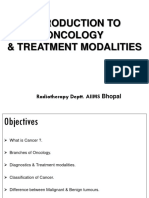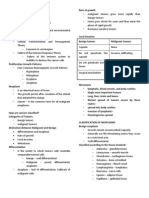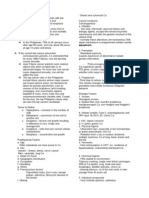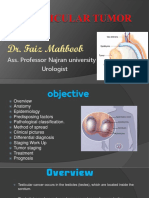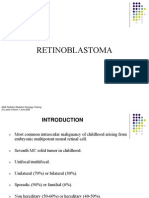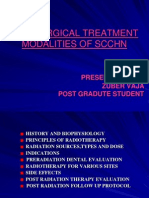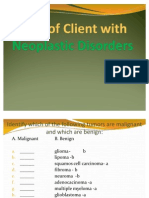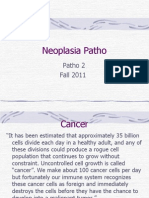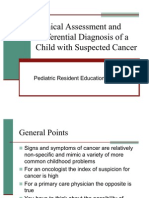Oncology Notes
Oncology Notes
Uploaded by
makbbmakCopyright:
Available Formats
Oncology Notes
Oncology Notes
Uploaded by
makbbmakOriginal Description:
Copyright
Available Formats
Share this document
Did you find this document useful?
Is this content inappropriate?
Copyright:
Available Formats
Oncology Notes
Oncology Notes
Uploaded by
makbbmakCopyright:
Available Formats
ONCOLOGY / CANCER NURSING THE CELL I.
Definition of Related Terms
Overview of Mitosis Cell division is an elegant process that enables organisms to grow and reproduce. Through a sequence of steps, the replicated genetic material in a parent cell is equally distributed to two daughter cells. While there are some subtle differences, mitosis is remarkably similar across organisms. Before a dividing cell enters mitosis, it undergoes a period of growth called interphase. Interphase is the "holding" stage or the stage between two successive cell divisions. In this stage, the cell replicates its genetic material and organelles in preparation for division. Mitosis is composed of several stages: Prophase- In prophase, the chromatin condenses into discrete chromosomes. The nuclear envelope breaks down and spindles form at opposite "poles" of the cell. Metaphase- In metaphase, the chromosomes are aligned at the metaphase plate (a plane that is equally distant from the two spindle poles). Anaphase- In anaphase, the paired chromosomes (sister chromatids) move to opposite ends of the cell. Telophase- In this last stage, the chromosomes are cordoned off in distinct new nuclei in the emerging daughter cells. Cytokinesis is also occurring at this time. At the end of mitosis, two distinct cells with identical genetic material are produced. Before a dividing cell enters mitosis, it undergoes a period of growth called interphase. Some 90 percent of a cell's time in the normal cellular cycle may be spent in interphase. Stages of Interphase
1. 2. 3. 4. 5. 6.
Cell - the basic unit of living organism; can reproduce itself Cancer- a disease process whereby cells proliferate abnormally, ignoring growth regulating signals in the environment surrounding the cells. Carcinoma- a new growth or malignant tumor that originates from epithelial cells, the skin, GIT, Lungs, Uterus, breast and other organs. Benign- usually a reference to growths that are encapsulated, remain localized, and are slow growing Malignant- terms for growth that are encapsulated but metastasize and grow. These growths are cancerous lesions having the characteristics of disorderly, uncontrolled proliferation of the cell Tumor- abnormal swelling usually from inflammation, or from morbid enlargement.
7. 8. 9.
they are uncontrolled tissue growth that in which cell rapidly multiplies
Oncology- the study of cancer Staging- a method of classifying malignancies based on the presence and extent of the tumor on the body Metastasis- the transfer of disease from one organ or apart to another not directly connected to it. cells- cells that lost the capacity for specialized functions process of transforming normal cells into or promote cellular malignant cells
10. Undifferentiated 11. Carcinogenesis12. Carcinogenstransformation.
agents that initiate
G1 phase: The period prior to the synthesis of DNA. In this phase, the cell increases in mass in preparation for cell division. Note that the G in G1 represents gap and the 1 represents first, so the G1 phase is the first gap phase.
13. Oncogene- cancer gene that alters the normal cell 14. Carcinoma- usually solid tumors arising from epithelial cell 15. Sarcoma- from muscle, bone, fat and other connective tissue 16. Lymphoma- malignant tumors in lymphatic system 17. Leukemia- cancer of the blood 18. Nadir- lowest point of WBC depression after therapy that has
toxic effects on th bone marrow
S phase: The period during which DNA is synthesized. In most cells, there is a narrow window of time during which DNA is synthesized. Note that the S represents synthesis.
19. Metastasis- spread of cancer cells from the primary tumor to
distant sites. Review of Anatomy and Physiology: Cell Centrioles- self-replicating organelles made of nine bundles of microtubules and are found only in animal cells Cilia and Flagella- essential for locomotion (single-celled). Cilia function to move fluid or materials past an immobile cell as well as moving a cell or group of cells. Endoplasmic Reticulum a network of sacs that manufactures, processes and transports chemical compounds for use inside and outside of the cell. Provides a pipeline between the nucleus and the cytoplasm. Golgi apparatus The distribution and shipping department for the cells chemical products Lysosymes- Main function is digestion. It breaks down cellular waste products and debris from outside the cell into simple compounds, which are transferred to the cytoplasm as new cell-building materials. Mitochondria - are oblong shaped. The main power generators, converting oxygen and nutrients into energy Nucleus - Serves as the information processing and administrative center of the cell. Stores DNA Coordinates cell activities o Growth o Intermediary metabolism o Protein synthesis o Reproduction (cell division) Perixosomes - found inside the cytoplasm Plasma membrane encloses cell contents. Selectively permeable. Ribosomes- comprised of approx. 60% RNA and 40% protein Cell Division
G2 phase: The period after DNA synthesis has occurred but prior to the start of prophase. The cell synthesizes proteins and continues to increase in size. Note that the G in G2 represents gap and the 2 represents second, so the G2 phase is the second gap phase.
In the latter part of interphase, the cell still has nucleoli present.
The nucleus is bounded by a nuclear envelope and the cell's chromosomes have duplicated but are in the form of chromatin. In animal cells, two pair of centrioles formed from the replication of one pair are located outside of the nucleus.
Pathogenesis of Cancer a. Cellular Transformation & Derangement Theory Conceptualizes that normal cells may be transformed into cancer cells due to exposure to some etiologic agents. b. Failure of the Immune Response Theory
Tobacco smoke single most lethal chemical carcinogen 30% of Ca deaths Chemical substances found in workplace (amines, aniline dyes, pesticides and formaldehydes, arsenic, tars, asbestos, benzene, Cadmiun, Nickel and Zinc ores, PVCs etc.)
D.
Chemical agents alters DNA structure in body sites distant from chemical exposure (liver, lungs and kidneys are most commonly affected) GENETIC & FAMILIAL FACTORS Genetics, shared environments, cultural or lifestyle factors, chance. DIETARY FACTORS
Advocates that all individuals possess cancer cells. However, the cancer cells are recognized by the immune response system. So, the cancer cell undergoes destruction. Failure of the immune response system leads to inability to destroy the cancer cells.
E.
Proactive (protective) substances High fiber, cruciferous vegetables, carotenoids, Vit. E & C, Zinc and Selenium
ROLE OF THE IMMUNE SYSTEM malignant cells are capable of developing on a regular basis Immune system can detect the development of malignant cells and destroys them before cell growth becomes uncontrolled. Clinical cancer develops when the immune system fails to identify and stop the growth of malignant cells. F.
Cacinogenic & Co-Carcinogenic substances High fat, Low Fiber, Alcohol, Salt-cured or smoked meats, foods w/ nitrates & nitrites, High Caloric. HORMONAL AGENTS Endogenous vs. Exogenous hormones DES (Diethylstilbestrol) vaginal carcinomas Oral contraceptives and prolonged estrogen replacement therapy
Predisposing Factors Age - Older individuals are more prone to cancer, they have been exposed to carcinogens longer, they may have developed immune system alteration. Sex - Women = more prone to breast, uterus, cervical cancer Men = more prone to prostate, lung cancer Residence - Urban dwellers are more prone to cancer than Rural dwellers. Geographic distribution Japan = cancer of the stomach US = cancer of the breast Due to influence of environmental factors such as, national diet, ethnic customs, type of pollutions Occupation - Chemical factory workers, farmers, radiology department person Heredity - Greater risk with positive family history Stress - Depression, grief, anger, aggression, despair or life stresses decreases immunocompetence (affect hypothalamus and pituitary gland) immunodeficiency may spur the growth and proliferation of cancer cells Precancerous lesions May undergo transformation into Ca lesions and tumors. E.g. pigmented moles, burn scars, senile keratosis, leoukoplakia, benign polyps/adenoma of the colon or stomach, fibrocystic disease of the breast Obesity - Studies have linked obesity to breast and colorectal Ca American Cancer Society 7 Warning Signs (CAUTION) CAUTI ONChange in bowel or bladder HABITS A sore that does not heal Unusual bleeding or discharges Thickening or a lump in the breast or elsewhere Indigestion and difficulty of swallowing Obvious change in a wart or a mole Nagging cough or hoarseness of the voice
Normal Immune Response recognizes as foreign certain antigens(tumor associated antigens) on the cell membrane of cancer cells macrophages, T lymphocytes, soldiers of the cellular immune response T-lymphocytes has cytotoxic properties
Lymphokines produced by lymphocytes, capable of killing or damaging various types of malignant cells Interferon(IFN) produce by the body in response to viral infection, possesses anti tumor properties. Natural Killer Cells subpopulation of lymphocytes, producing lymphokines and certain enzymes that kills tumors
Immune System Failure -
Body fails to recognize malignant cells as different from self Immune response may not be activated Tumor antigens combine with antibodies produced by the immune system and hides/disguise themselves from normal immune defense mechanism.
ASSESSMENT ETIOLOGY:
A.
B.
C.
VIRUSES & BACTERIA viruses incorporate themselves in the genetic structure of cells, altering future generation of that cell population perhaps leasing to Cancer. e.g. Epstein-Barr Virus Highly suspect as a cause in - Burkitts lymphoma - Nasopharyngeal Ca - some types of non-Hodgkins Lymphoma - Hodgkins Disease Herpes Simplex II, CMV, HPV 16, 18, 31, 33 o Dysplasia o Ca of the cervix Hepatitis B virus o Liver Ca Human T cell lymphotropic Virus o lymphocytic leukemia o lymphomas HIV o Kaposis Sarcoma Helicobacter pylori (bacteria) o Gastric Malignancy PHYSICAL AGENTS a. Exposure to UV rays of the sun b. Exposure to Ionizing radiation c. Chronic inflammation or Irritation d. Tobacco use CHEMICAL AGENTS 75 % of all Ca are thought to be related to the environment
Cancer Classification 1. Solid Tumors Associated with the organs from which they develop. Such as breast cancer or lung cancer Hematological Cancer Originate from blood cell-forming tissues, such as the Leukemia sans the Lymphomas
2.
Characteristic of Malignant vs. Benign neoplasm CHARAC TERISTI CS Rate of growth BENIGN Usually slow MALIGNANT Variable and depends on level of differentiation; the more anaplastic the tumor, the faster its growth
Mode of growth
Cell characteri stics
Grows by expansion; does not infiltrate surrounding tissues; usually encapsulated Well differentiated cells that resembles normal cells of the tissues from which the tumor originated
Grows at he periphery and sends out processes that infiltrate and destroy surrounding tissues Undifferentiated and often bear little resemblance to the normal cells of the tissue from which they arose STAGING
Metastasis
Not spread metastasis
by
General effects
Tissue destructio n
Usually a localized phenomenon that does not cause generalized effects unless its location interferes with blood flow Does not usually cause tissue damage unless its location interferes with blood flow
Gains access to the blood and lymphatic channels and metastasizes to other areas of the body Often causes generalized effects such as Anemia, Weakness, and weight loss Often causes extensive tissue damage as the tumor outgrows its blood supply or encroaches on blood flow to the area; may also produce substances that cause cell damage Usually causes death unless growth can be controlled
PRIMARY AND SECONDARY PREVENTION Primary prevention concerned with reducing the risk of cancer in healthy people - Client Education and counseling. (Avoidance of Carcinogens and dietary and lifestyle changes). Secondary Prevention involves detection and screening to achieve early diagnosis and prompt intervention to halt cancer process. EARLY DETECTION 1. 2. 3. 4. 5. 6. 7. DIAGNOSTIC TESTS 1. Blood analysis health care - an unestablished diagnostic test used by some practitioners to determine a course of treatment RBC, WBC, Platelets 2. Bone Marrow Examination refers to the pathologic analysis of samples of bone marrow obtained by bone marrow biopsy (Trephine) and bone marrow aspiration. Bone Marrow Biopsy removal of soft tissue from inside of the bone. Bone marrow grows inside some larger bones in the body. It produces platelets and red and white blood cells. 3. Radiographic / imaging tests Mammography Papanicolaous (Pap) smear Stools for occult blood Sigmoidoscopy: colonoscopy Breast self-examination Testicular Self Examination Skin inspection
Ability to cause death
Does not usually cause death unless its location interferes with vital functions
Grading and Staging of Tumors Staging determines the size of the tumor and the existence of metastasis TNM system most frequently used system in classifying the extent of disease. T Extent of Primary Tumor N Lymph node involvement M extent of mmetastasis Primary Tumor (T) TX Primary tumor cannot be assessed T0 No evidence of primary tumor Tis carcinoma in situ T1, T2, T3, T4 increasing size and / or local extent of the primary tumor Regional Lymph Node (N) NX Regional lymph nodes cannot be assessed N0 No regional Lymph node metastasis N1,N2,N3 Increasing involvement of regional lymph nodes Distant Metastasis (M) MX distant metastasis cannot be assessed M0 No distant metastasis M1 Distant metastasis Grading refers to the classification of the tumor cells. seeks to define the type of tissue from which the tumor originated and the degree to which the tumor cells retain the functional and histologic characteristics of the tissue of origin.
TEST Tumor marker identificatio n MRI
DESCRIPTION Analysis of substances found in blood or other body fluids that are made by the tumor or by the body in response to the tumor. Use of magnetic fields and radiofrequency signals to create sectioned images of various body structures Use of Narrow beam xray to scan successive layers of tissues for cross-sectional views Use of x-rays that identify contrasts in body tissue densities; may use contrast agents Direct visualization of a body cavity or passageway by insertion of an endoscope into a body cavity or opening; allowing tissue biopsy,
DIAGNOSTIC USES Breast, colon, lung, ovarian, testicular, prostate Cancer Neurologic, pelvic, abdominal, thoracic cancers Neurologic, pelvic, skeletal, abdominal, thoracic cancers Abdominal and pelvic cancers Bronchial, GI cancer
done through Cytology, Biopsy, Surgical Excision. CT scan
GRADING Grade I Grade II Grade III Grade IV Cells differ slightly from normal cells and are well differentiated (mild dysplasia) Cells are more abnormal and are moderately differentiated (moderate dysplasia) Cells are very abnormal and are poorly differentiated (severe dysplasia) Cells are immature (anaplasia) and undifferentiated; cell of origin is difficult to determine
Fluoroscop y Endoscopy
fluid aspiration and excision of small tumors; both diagnostic and therapeutic PET scan Computed crossLung, colon, sectional images of liver, pancreas, increased concentration breast, of radioisotopes in esophagus malignant cells provide cancer; information about Hodgkins and biologic activity of non-Hodgkins malignant cells; helps lymphoma and identify if malignant or Melanoma. just benign Radioimmu Monoclonal antibodies Colorectal, noconjugat are labeled with a breast, ovarian, es radioisotope and head and neck injected intravenously cancers; into the patient; lymphoma and antibodies aggregate at melanoma the tumor site then visualized with scanners 4. Biopsy the definitive means of diagnosing cancer and provides histological proof of malignancy involves surgical incision of a small piece of tissue for microscopic examination Types: a. Needle - Aspiration of cells b. Incisional - Removal of a wedge of suspected tissue from a larger mass c. Excisional - Complete removal of the entire lesion d. Staging - Multiple needle or incisional biopsies in tissues where metastasis is suspected or likely. *** surgical setting > procedure is usually performed in an outpatient
c. Angiogenesis
Ability of malignant cells to induce growth of new capillaries from the host tissue to meet their needs for nutrients and oxygen.
Carcinogenesis - a.k.a. Malignant transformation; has three-step cellular process a. Initiation Carcinogens escape normal enzymatic mechanisms and alter the genetic structure of the cellular DNA (Permanent cellular mutations) b. Promotion repeated exposure to co-carcinogens causes the expression of abnormal or mutant genetic information even after long latency periods. Cellular oncogenes responsible for the vital cellular functions of growth and differentiation. Cellular Proto-oncogenes acts as an ON switch for cellular growth. Cancer Suppressor genes turn OFF or regulate unneeded cellular proliferation when mutated, rearranged, amplified, or lose their regulatory capabilities, malignant cells reproduce. P53 gene - tumor suppressor gene that is frequently mutated in many human cancers. regulates whether cells will repair or die after DNA damage. c. Progression Cellular changes exhibit increased malignant behavior. - cells shows propensity to invade adjacent tissues and to metastasize. Cellular Aberration 1. Ca Cell Proliferation disrupts normal cell growth and interfere with tissue function Manifestation: Pressure Obstruction Pain Effusion Ulceration Vascular Thrombosis, Embolus, Thrombophlebitis 2. Paraneoplastic Syndrome Malignant cells produce enzymes, hormones and other substances. Manifestation: Anemia Hypercalcemia Edema DIC 3. Anorexia Cachexia Syndrome Manifestation: Tissue wasting Severe weight loss Severe Debilitation Paradigm (Carcinogenesis and cellular aberration)
> Prepare Client Physically and psychologically and following physicians Instructions > Obtain an Informed consent Pathophysiologic Basis of Malignant Neoplasm Cancer is a disease process that begins when an abnormal cell is transformed by the genetic mutation of the cellular DNA. This abnormal cell forms a clone and begins to proliferate abnormally, ignoring growth regulating signals in the environment surrounding the cell. The cells acquire invasive characteristics, and changes occur in surrounding tissues. The cells infiltrate these tissues and gain access to lymph and blood vessels, which carry the cells to other areas of the body. This phenomenon is called Metastasis. Cancer is not a single disease with a single cause; rather, it is a group of distinct diseases with different causes, manifestations, treatments and prognoses.
Proliferative patterns Hyperplasia tissue; most often associated Metaplasia type of cell Dysplasia size, shape, or Anaplasia differ in shape Increase in the number of cells of a
with periods of rapid body growth conversion of one type of mature cell into another bizarre cell growth resulting in cells that differ in arrangement from other cells of the same type of tissue. cells that lack normal cellular characteristics and and organization with respect to their cells of origin; usually, anaplastic cells are malignant Uncontrolled cell growth that follows no
THERAPEUTIC MODALITIES FOR CANCER A. SURGERY - used to diagnose, stage and treat cancer Approaches: a. Local excision warranted if the mass is small removal of the mass and a small margin of normal tissue that is easily accessible b . Wide or Radical excision (en bloc dissection) removal of primary tumors, lymph nodes, adjacent involved structures, and surrounding tissues that may be at high risk for tumor spread. considered if the tumor can be removed completely and the chances of cure or control are good.
Neoplasia physiologic demand.
Invasion and Metastasis Metastatic Mechanism a. Lymphatic spread the lymphatic circulation. b. Hematogenous spread disseminated through the - most common. malignant Through cells are
bloodstream. Directly related to the vascularity of the tumor.
Salvage Surgery uses an extensive surgical approach to treat the local recurrence of the cancer after a less extensive primary approach is used. E.g. mastectomy to treat recurrent breast Ca after primary lumpectomy and radiation
Electrosurgery makes use of electrical current to destroy the tumor cells Cryosurgery uses liquid nitrogen to freeze tissue to cause cell destruction Chemosurgery uses combined topical chemotherapy and layer-by-layer surgical removal of abnormal tissue Laser surgery makes use of light and energy aimed at an exact tissue location and depth to vaporize cancer cells Stereotactic Radiosurcegy (SRS) single and highly precise administration of high dose radiation therapy used in some types of brain and head and neck cancers. TYPES:
3.
Venoocclusive disease
B. RADIATION THERAPY destroys cancer cells with minimal exposure of normal cells to the damaging effects of radiation. The cells damaged die or become unable to divide effective on tissues directly within the path of the radiation beam. Side Effects: Skin changes and irritation Alopecia Fatigue Altered taste sensation -
a.
Prophylactic Sx performed in clients with an existing premalignant condition or a known family history that strongly predisposes the person to the development of cancer - an attempt is made to remove the tissue or organ at risk and thus prevent the development of cancer Curative Sx all gross and microscopic tumor is removed or destroyed
a.
b. c.
Control (Cytoreductive) Sx a debulking procedure that consist of removing part of the tumor - Sx decreases the number of cancer cells and increases the chance that other therapies will be successful d. Palliative Sx performed to improve quality of life during the survival time. - to reduce pain, relieve airway obstruction, relieve obstructions in the GI or Urinary tract, relieve pressure on the brain or spinal cord, prevent hemorrhage, remove infected or ulcerated tumors, or drain abscesses. e. Reconstructive / Rehabilitative Sx performed to improve quality of life by restoring maximal function and appearance suh as breast reconstruction after Mastectomy Side Effects: 1. Loss or loss of function of a specific body part 2. Reduced function as a result or organ loss 3. Scarring or disfigurement 4. Grieving about altered body image or imposed change in lifestyle Nursing Management: general perioperative nursing care Education and emotional support o Assessing Pt. and Family needs, fears, coping mechanisms o Encourage to take an active role in decision making when possible o Explain laboratory findings based on information the physician previously conveyed to them when the Pt. and the family asks. Asses Pts response to the Sx Monitor for possible complications ( Infection, bleeding, thrombophlebitis, wound dehiscence, F & E imbalance, and organ dysfunction ) Provide comfort Provide post-op teaching (wound care, activity, nutrition, medication information)
Types: External ( Teletherapy) also called beam radiation; radiation source is external to client. client does not emit radiation and does not pose a hazard to anyone else Client education: wash area with mild soap and water using hand rather than washcloth rinse thoroughly and pat dry do not remove radiation markings from the skin no powders, ointments, lotions or creams on the areas unless prescribed avoid sun and heat exposure monitor for moist desquamation (weeping of the skin) if moist desquamation occurs, cleanse the area with warm water ad pat dry, apply antibiotic ointment as prescribed. Internal (Brachytherapy) radiation source comes in direct, continuous contact with tumor tissues for a specific time radiation source is within the client, for a period of time, client emits radiation and can pose hazard to everybody Sealed vs. Unsealed source
b.
Unsealed -via ORAL, IV or instillation to body cavities - eliminated in various excreta which are radioactive and harmful to others - Sealed - solid, temporary or permanent, is implanted within the tumor target tissues - client emits radiation while the implant is in place, but the excreta are not radioactive Care of the client with a sealed radiation Source: Private room with a private bath Caution sign on the door Minimize exposure to the radiation source Limit time to 30 mins per care provider per shift Wear docimeter badge Principles of Timing Distance and Shielding Limit Visitors C. CHEMOTHERAPY Chemotherapy, in its most general sense, refers to treatment of disease by chemicals that kill cells, specifically those of micro-organisms or cancer. In popular usage, it will usually refer to antineoplastic drugs used to treat cancer or the combination of these drugs into a standardized treatment regimen. In its non-oncological use, the term may also refer to antibiotics (antibacterial chemotherapy). In that sense, the first modern chemotherapeutic agent was Paul Ehrlich's arsphenamine, an arsenic compound discovered in 1909 and used to treat syphilis. This was later followed by sulfonamides discovered by Domagk and penicillin discovered by Alexander Fleming. Other uses of cytostatic chemotherapy agents (including the ones mentioned below) are the treatment of autoimmune diseases such as multiple sclerosis and rheumatoid arthritis and the suppression of transplant rejections Objectives: To destroy all malignant tumor cells without excessive destruction of normal cells
BONE MARROW TRANSPLANTATION to treat leukemia in clients who have closely matched donors and who are experiencing temporary remission with chemotherapy TYPES: a. Allogenic Marrow donor is sually a sibling or parent with a similar tissue type b. Syngeneic from an identical twin c. Autologous most common type marrow donor is also the recipient marrow is harvested during disease remission and is stored frozen to be infused later PROCEDURE: 1. 2. 3. 4. Harvest Conditioning Transplantation Engraftment
COMPLICATIONS: 1. Failure to engraft 2. Graft-versus-Host disease
To control tumor growth if cure is no longer possible Used as adjuvant therapy Contraindications: Infection. The anti-tumor drugs are immunosuppresives
Recent surgery. The drugs may retard healing process Impaired renal / hepatic function. nephrotoxic & hepatotoxic The drugs are
Recent Radiation Therapy. Also immunisuppresive Pregnancy. The drugs may cause congenital defects Bone Marrow Depression. The drugs may aggravate the condition. The WBC level must be within normal limits.
AntiNeoplastic Medications Kills or inhibit the reproduction of neoplastic cells Normal cells are also affected Cell cycle phase specific medications o Affects cells only during a certain phase of the reproductive cycle Cell cycle phase non-specific medications o Affects cells in any phase of the reproductive cycle Can use combination medications or with other treatment modalities Side Effects:
Classifications Classification I. ALKYLATING MEDS Side effects Gonadal Suppressio n, Hemorrhagi c cystitis, Alopecia, Hematuria Examples Nitrogen Mustards Cyclophosphamid e (Cytoxan) Ifosfamide(Ifex) Nitrosoureas Carmustine(BiCN U) Streptozocin(Zano sar) Alkylating-like Cisplatine(Platinol ) Thiotepa (Thioplex) Bleomycin Sulfate(Blenoxane ) Daunorubicin (Cerubidine) Doxorubicin(Adria mycin) Plicamycin(Mithra cin) Dactinomycin(Act inomycin D) 5-Fluouracil (Adrucil) 6Mercapturine(Puri nethol) Methotrexate (Folex) Vincristine Sulfate(Oncovin) Teniposide(Vamo n)
Cell cycle nonspecific
1.
2.
3.
4. 5.
G.I. System Nausea & Vomiting, Diarrhea, constipation, anorexia Integumentary System a. Pruritus, urticaria & systemic signs b. Stomatitis c. Alopecia d. Skin pigmentation e. Nail changes Hematopoetic system a. Anemia b. Neutropenia c. Thrombocytopenia Genito Urinary system a. Hemorrhagic cystitis b. Urine color changes Others
II.ANTITUMOR ANTIBIOTICS
Cell cycle nonspecific
a. b. c.
d.
Pain Malnutrition Memory loss Weight loss or gain Hemorrhage Secondary neoplasms Cardiotoxicity Hepatotoxicity Nephrotoxicity Ototoxicity tumor lysis syndrome post-chemotherapy cognitive impairment("chemo brain") Infertility V. HORMONAL MEDS / ENZYMES Monitor V/S and lab values Bleeding precaution Neutropenic precaution Nutrition (High calorie with protein supplements) Antiemetics (12-48 hours before) Hydration Administer Allopurinol for increased Uric Acid Health care provider safety Advise purchase of wig Hair growth occurs several months after the final treatment Contraception = teratogenic effects of meds IV. MITOTIC INHIBITORS (Vinca Alkalopids) Cell cycle specific (M Phase) III. ANTIMETABO LITES Cell cycle specific (S Phase)
Bone Marrow depression, Gonadal Suppressio n, Vesication
e. f. g. h. i. j. k. l.
m. Interventions:
Slows growth rate of tumors
VI. OTHERS
ESTROGEN:Diet hylstilbestrol ANTIESTROGEN: Tamoxifen citrate ANDROGENS:Te stosterone ANTIANDROGENS:Fl utamide PROGESTINS:Me droxyprogesterone (Depo-provera) OTHERS: Asparginase,Mitot ane Immunomodulator agents = Interleukins / Interferon Colony-stimulating factors = Erythropoietin (Epogen)
Bone marrow suppression , stomatitis, photosensiti vity, hepatotoxic ity Neurotoxici ty, Leukopenia , Ptosis, Constipatio n, Peripheral Neuropathy Leukopenia , gynecomast ia, hot flashes, sex characterist ic alterations
Precipitating factors: low social economic groups early first marriage early & frequent intercourse multiple sex partners high parity poor hygiene Assessment: CANCER TYPES BREAST CANCER Invasive mammary duct & Metastasis when it penetrates the tissue surrounding the grows in an irregular patter via lymph nodes to Bones, lungs, brain and liver Diagnosis: (cytological changes) on Pap Smear SURGICAL - Conization - Hysterectomy - Pelvic Management: NON-SURGICAL -Chemotherapy cryosurgery - External radiation exenteration - Internal radiation implants (intracavitary) - laser therapy Painless vaginal bleeding postmenstrually & post coitally Foul smelling / serosanguinous vaginal discharge Pelvic / lower back/leg/groin pain Anorexia & wt. loss Leakage of urine & feces from the vagina Dysuria Hematuria
Precipitating factors:p 1. family History 2. Early menarche / late menopause 3. Previous Ca of Breast, Uterus or ovaries 4. Nulliparity 5. Obesity 6. High dose exposure of radiation to chest Assessment: BSE - Mass felt ( Upper outer quadrant / beneath the nipples ) Fixed, irregular, non-encapsulated Painless (except in late stages) Nipple retraction / elevation Assymetry (affected breast higher) Discharges (bloody / clear) Edema / paeu dorange sin Lymphedema/lymphadenopathy Lesion seen on mammography Diagnosis: 1. 2. Breast biopsy (needle aspiration) Surgical removal of tumor (for microscopic examination) SURGICAL -Lumpectomy -Simple mastectomy -MRM -Halstead radical -Oophorectomy (for estrogen receptor (+)tumor) -Ablative therapy w/ adrenalectomy or chemical ablatio n (block s the produc tion of cortiso l/ andros tenedi one / aldost erone) Post-op: 1. 2. 3. 4. 5. 6. Monitor v/s positioning - (Semifowlers ,Back to unaffected side, affected arm elevated above the level of the heart) Deep breathing and coughing exercise Monitor operative site for infection/swelling/drainage No IV, Injection, BP taking, venipuctures in affected arm diuretics & low salt diet
OVARIAN CANCER Grows rapidly / spreads fast / often bilateral Prognosis usually is poor (tumor detected late) Assessment: Diagnosis: Intervention: 1. 2. 3. 4. 5. Exploratory Laparotomy (to diagnose & to stage tumor) External Radiation Chemotherapy (Post-op / for all stages) Intraperitoneal Chemotherapy (abdominal Cavity) Immunotherapy TAHBSO Abdominal discomfort / swelling GI disturbances Dysfunctional vaginal bleeding Abdominal mass
Intervention: NON-SURGICAL -Chemotherapy - Radiation Therapy -Hormonal manipulation Mastectomy
HODGKINS DISEASE (Lymphoma) malignancy of the lymph nodes Metastasis to other lymph nodes and eventually nonlymphoid tissues Usually affects lymph nodes, spleen and bone marrow
Etiology: Assessment: -
Distinguishing sign : Reed-sternberg cell viral infection previous exposure to alkylating chemical agents Fever Malaise, fatigue, weakness Night sweats Loss of appetite and significant wt. loss Enlarged lymph nodes, spleen & liver Anemia & thrombocytopenia
STAGING in HODGKINs DISEASE I involvement of a single lymph node region or in extra lymphatic organ / site II two or more lymph node regions on the same side of diapraghm or localized involvement of an extralymphatic organ / site III lymph node regions on both side of the diapraghm IV diffuse or disseminated involvement of one or more extralymphatic organs w/ or w/o associated lymph node involvement Diagnosis: Intervention; 1. for stage I & II extensive external radiation of the involved lymph node regions 2. radiation with multi-agent chemotherapy 3. Maintain infection & bleeding precaution 4. Inform male clients about possibility of sterility (discuss options like sperm banking) MULTIPLE MYELOMA Biopsy (cervical nodes affected first) (+) and with REED-STERNBERG CELL CT SCAN (Liver & spleen)
CERVICAL CANCER Pre invasive Ca (Cervical intraepithelial neoplasia) o I Mild dysplasia o II Moderate dysplasia o III severe dysplasia to carcinoma in situ Metastasis confined to the pelvis but may have lymphatic spread
malignant proliferation of plasma cells and tumors within the bone plasma cells tumors destroys bones abnormal plasma cells produce abnormal antibody (myeloma protein or the Bence-Jones protein) found in blood and urine. Causes decrease production of (immunoglobulins & antibodies) Causes increase levels of (Uric acid & calcium) leading to RENAL FAILURE unknown Skeletal pain (pelvis, spine, ribs) weakness & fatigue Recurrent infections Anemia Osteoporosis Renal failure Spinal cord compression & paraplegia Blood tests (elevated serum protein, thrombocytopenia, granulocytopenia, elevated uric acid & calcium levels) Urine exams (presence of Bence-Jones protein) Chemotherapy Supportive care (to control symptoms & prevent complications) Maintain Neutropenic & Bleeding precautions Fluids 3-4 L/day Monitor for signs of Renal Failure Encourage ambulation IV Fluids & diuretics, blood transfusion, analgesics, antibiotics as prescribed
Exposure to Radiation, Chemicals, Medications Signs / Symptoms:
Etiology: Assessment: 1. 2. 3. 4. 5. 6. 7. Diagnosis: Intervention: 1. 2. 3. 4. 5. 6. 7. LEUKEMIA
people with leukemia may become bruised, bleed excessively, or develop pinprick bleeds (petechiae). Immunosuppression anemia dyspnea. Fever, chills, night sweats and other flu-like symptom Weakness and fatigue Swollen or bleeding gums Neurological symptoms (headaches) Enlarged liver and spleen Frequent infection Bone pain Joint pain Dizziness Nausea Swollen tonsils Diarrhea Paleness Malaise Unintentional weight loss
Diagnosis
Diagnosis requires blood tests to look for an abnormal number of white blood cells, and a bone marrow examination to look for abnormal numbers or forms of cells in the bone marrow. Management:
Induction chemotherapy to bring about bone marrow remission. Consolidation therapy to eliminate any remaining leukemia cells. CNS prophylaxis (preventive therapy) to stop the cancer from spreading to the brain and nervous system. Maintenance treatments with chemotherapeutic drugs to prevent disease recurrence once remission has been achieved. Alternatively, allogeneic bone marrow transplantation may be appropriate for high-risk or relapsed patients. Single agent chemotherapy Combination Chemotherapy Protective isolation Bleeding precaution Monitor v/s & lab values Nutrition Radiation Therapy
- Leukemia or leukaemia (Greek leukos , "white"; aima , "blood") is a cancer of the blood or bone marrow and is characterized by an abnormal proliferation (production by multiplication) of blood cells, usually white blood cells (leukocytes). Leukemia is clinically and pathologically subdivided into several large groups. The first division is between its acute and chronic forms:
Acute leukemia is characterized by the rapid increase of immature blood cells. This crowding makes the bone marrow unable to produce healthy blood cells. Acute forms of leukemia can occur in children and young adults. (In fact, it is a more common cause of death for children in the US than any other type of malignant disease). Immediate treatment is required in acute leukemias due to the rapid progression and accumulation of the malignant cells, which then spill over into the bloodstream and spread to other organs of the body. Central nervous system (CNS) involvement is uncommon, although the disease can occasionally cause cranial nerve palsies. Chronic leukemia is distinguished by the excessive build up of relatively mature, but still abnormal, blood cells. Typically taking months or years to progress, the cells are produced at a much higher rate than normal cells, resulting in many abnormal white blood cells in the blood. Chronic leukemia mostly occurs in older people, but can theoretically occur in any age group. Whereas acute leukemia must be treated immediately, chronic forms are sometimes monitored for some time before treatment to ensure maximum effectiveness of therapy.
LIVER CANCER Associated with Chronic liver disease / Hepa-B/ HepaC / Cirrhosis Risk Factors: Cigarette Smoking Alcohol Use Metastasis: Portal Circulation Lymphatic changes Direct extension Signs / Symptoms: Pain (RUQ/ Epigastrium/ Bask) Wt. Loss / Anorexia Loss of strength Anemia Enlarged liver Ascites Jaundice Diagnosis: Lab Exams Increased serum levels of Alpha FetoProtein (AFP) X-rays Liver scans CT Scan UTZ MRI Arteriography Laparoscopy PET Scans BIOPSY Management: NON-SURGICAL: SURGICAL:
Four major kinds of leukemia Acute Chronic Acute lymphocytic Chronic lymphocytic Lymphocytic leukemia leukemia (ALL) leukemia (CLL) (or "lymphoblastic") Onset: <15y.o. Onset: >50y.o Chronic myelogenous Myelogenous leukemia Acute myelogenous leukemia (CML) (also "myeloid" or leukemia (AML) Onset:>50 y.o. "nonlymphocytic") Onset: 15-39 y.o. (mostly granulocytes) Cause: Unknown Gene damage of cells(suspect) Risk Factors: Genetic Viral Environmental Immunological Cell type
Radiation Therapy - Hepatic Resection Chemotherapy Lobectomy Immunotherapy Cryosurgery Percutaneous Billiary Drainage Transplantation Laser Hyperthermia
o - Liver Cause: o
Primary = Originated from cells & structures within the brain Secondary = Metastatic / develops from structures outside the brain
LUNG CANCER Can be Primary or Metastatic Bronchogenic Carcinoma spreads thru direct extension & lymphatic dissemination 4 major types: 1. Small Cell (Oat cell) 2. Epidermal (Squamous cell) 3. Adenocarcinoma 4. Large cell anaplstic carcinoma Diagnosis: CXR Bronchoscopy Sputum Studies Causes: Cigarette smoking Exposure to Environmental pollutants Exposure to Occupational pollutants Signs / Symptoms: Cough Dyspnea Hoarseness Hemoptysis Chest pain Anorexia / Wt. loss Weakness Interventions: Monitor v/s Position : High Fowlers position Assess for tracheal deviation Oxygen with humidifier Pulse oximeter Meds: Analgesics, Bronchodilators, corticosteroids Nutrition: High calorie, protein, vitamins NON-SURGICAL SURGICAL Radiation therapy - Laser Therapy Chemotherapy - Thoracentesis / Pleurodesis Immunotherapy - Thoracotomy with pneumonectomy o Thoracotom y with lobectomy o Thoracotom y with segmental resection PROSTATE CANCER SLOW GROWING Usually androgen dependent type of adenocarcinoma Risk = increases in men each decade after 50 y/o Metastasis= direct invasion, bloodstream & lymphatics, to bone (a concern) Diagnosis: DRE PSAT Confirmed if with increased in Serum acid phosphatase Signs/Symptoms: Early stage = asymptomatic Hard, peas sized nodule Hematuria Urinary obstruction Pain (Radiating from lumbosacral area down the leg) Intervention: NON-SURGICAL SURGICAL Hormone manipulation therapy - orchiectomy(palliative) Radiation Therapy = decreased testosterone Chemotherapy (Hormone resistant tumors) TURP o Prostatectomy o Cryosurgical Ablation BRAIN TUMOR LOCALIZED / INTRACRANIAL LESION Effects are due to compression & infiltration of tissues Primary vs. secondary
Unknown Risk Factor: Exposure to ionizing radiation Greater in men than in women Signs / Sypmtoms: 1. Increased ICP / Cerebral Edema 2. Seizure activity / focal neurologic signs 3. Hydrocephalus 4. Altered pituitary function Classification: I. INTRACEREBRAL TUMORS a. GLIOMAS infiltrate any portion of the brain; most common type of brain tumors i. ASTROCYTOMAS ii. GLIOBLASTOMA MULTIFORME iii. OLIGODENDROCYTOMA iv. EPENDYMOMA v. MEDULLOBLASTOMA II. ARISING FROM SUPPORTING STRUCTURES a. Meningiomas b. Neuromas c. Pituitary Adenomas III. DEVELOPMENTAL TUMORS a. Angiomas b. Dermoid, Epidermoid, Teroma, craniopharyngioma IV. METASTATIC LESIONS Diagnosis: CT SCAN MRI PET scan EEG Cytologic Studies Management: NON-SURGICAL SURGICAL Chemotherapy - craniotomy Radiation therapy - Laser / Radiotion (Iodine 131) Brachytherapy - Gamma Knife Corticosteroids Photodynamic therapy33699
You might also like
- HEMATOLOGY Multiple Choice Questions and AnswersDocument19 pagesHEMATOLOGY Multiple Choice Questions and AnswersZahraa Al-Sayed85% (20)
- Oxford Pediatric Oncology PDFDocument593 pagesOxford Pediatric Oncology PDFmondderNo ratings yet
- The Cell Definition of Related Terms: Oncology / Cancer NursingDocument23 pagesThe Cell Definition of Related Terms: Oncology / Cancer Nursingjesperdomincilbayaua100% (1)
- Oncology Nursing - OverviewDocument137 pagesOncology Nursing - OverviewMae Dacer100% (1)
- Colorectal Ca PresentationDocument25 pagesColorectal Ca Presentationapi-399299717No ratings yet
- Introduction To Oncology NursingDocument21 pagesIntroduction To Oncology NursingMelchor Felipe Salvosa83% (6)
- Oncology NursingDocument10 pagesOncology NursingMhaii Ameril88% (8)
- Nursing OncologyDocument124 pagesNursing OncologyAmisalu NigusieNo ratings yet
- Oncology (From The Ancient Greek Onkos - MeaningDocument11 pagesOncology (From The Ancient Greek Onkos - Meaningnycjg15No ratings yet
- 4th Lecture (NCM106 CA I) Care of Clients in Cellular Aberrations, ABC, Emergency and Disaster NursingDocument14 pages4th Lecture (NCM106 CA I) Care of Clients in Cellular Aberrations, ABC, Emergency and Disaster NursingKamx Mohammed100% (3)
- Oncology NursingDocument7 pagesOncology NursingDiana Laura Lei100% (1)
- Chemotherapy ProtocolsDocument6 pagesChemotherapy ProtocolsDenny LukasNo ratings yet
- Oncology LectureDocument92 pagesOncology Lecturerustie26No ratings yet
- Principles of OncologyDocument26 pagesPrinciples of OncologyDr Shahzad Alam ShahNo ratings yet
- Introduction To Oncology NursingDocument35 pagesIntroduction To Oncology NursingDesh Deepak100% (1)
- CancerDocument24 pagesCancerarshadmuhammedNo ratings yet
- Oncology NursingDocument10 pagesOncology NursingCham Rafaela Conese100% (3)
- Oncology NursingDocument12 pagesOncology NursingDick Morgan Ferrer80% (5)
- Medical-Surgical Nursing 2 Prepared by Dr. Peña and Dr. CabigonDocument9 pagesMedical-Surgical Nursing 2 Prepared by Dr. Peña and Dr. CabigonZONo ratings yet
- Oncology Handouts PDFDocument21 pagesOncology Handouts PDFPhilip Simangan100% (1)
- CHEMOTHERAPYDocument145 pagesCHEMOTHERAPYShweta MishraNo ratings yet
- Oncology Nursing: Chino Rhey L. de La RosaDocument120 pagesOncology Nursing: Chino Rhey L. de La RosaJoy Q. LimNo ratings yet
- B. Pathophysiology: Clinical Aspects of Cancer DiagnosisDocument10 pagesB. Pathophysiology: Clinical Aspects of Cancer DiagnosisAbigael Patricia GutierrezNo ratings yet
- Testicular Tumor - Dr. FaizDocument54 pagesTesticular Tumor - Dr. FaizFemale calmNo ratings yet
- Oncology MnemonicsDocument4 pagesOncology MnemonicsMuhammad Luqman Nul Hakim100% (3)
- Cancer ChemotherapyDocument9 pagesCancer ChemotherapyJennicaNo ratings yet
- Oncology NursingDocument4 pagesOncology Nursingfairwoods100% (2)
- CHEMOTHERAPYDocument5 pagesCHEMOTHERAPYL Rean Carmelle MAGALLONESNo ratings yet
- Chemo Protocol Administration - 2Document56 pagesChemo Protocol Administration - 2Peterpan NguyenNo ratings yet
- ONCOLOGYDocument26 pagesONCOLOGYShawn TejanoNo ratings yet
- Introduction To TransplantationDocument3 pagesIntroduction To TransplantationGerardLumNo ratings yet
- Oncology EmergencyDocument41 pagesOncology Emergencyomad pendaftaranPPDS100% (2)
- 050 PPT - RetinoblastomaDocument61 pages050 PPT - RetinoblastomaAnastasia TjanNo ratings yet
- Oncology Drug ListDocument11 pagesOncology Drug Listashrafh100% (1)
- Anticancer Drugs ClassificationDocument19 pagesAnticancer Drugs ClassificationMuhammad Raza100% (1)
- Oncologic NursingDocument132 pagesOncologic Nursingɹǝʍdןnos100% (10)
- Lecture Handouts Oncology NursingDocument12 pagesLecture Handouts Oncology NursingTiffany Luv AdriasNo ratings yet
- Care of The Clients With Cancer: Prof. Hashim N. Alawi Jr. RN, MANDocument78 pagesCare of The Clients With Cancer: Prof. Hashim N. Alawi Jr. RN, MANjisooNo ratings yet
- OncologyDocument54 pagesOncologyJhoana Rose Joaquin Santos100% (2)
- Oncology Nursing Handouts 1Document8 pagesOncology Nursing Handouts 1pauchanmnlNo ratings yet
- OncologyDocument5 pagesOncologymitzi019No ratings yet
- Modalities of Cancer TreatmentDocument65 pagesModalities of Cancer TreatmentBspharma 2E100% (1)
- Oncology Nursing HandoutsDocument7 pagesOncology Nursing HandoutsShandz de Rosas100% (1)
- Anticancer Drugs Anticancer Drugs: Tasneem Smerat Tasneem SmeratDocument118 pagesAnticancer Drugs Anticancer Drugs: Tasneem Smerat Tasneem Smeratanwar jabari100% (1)
- Non Surgical Treatment Modalities of SCCHN: Presentation by Post Gradute StudentDocument113 pagesNon Surgical Treatment Modalities of SCCHN: Presentation by Post Gradute StudentZubair VajaNo ratings yet
- Concurrent ChemoRadiotherapyDocument51 pagesConcurrent ChemoRadiotherapyJalal EltabibNo ratings yet
- Phyllodes Tumors of The Breast FINALDocument25 pagesPhyllodes Tumors of The Breast FINALchinnnababuNo ratings yet
- Colon CancerDocument17 pagesColon CancerYaska MusaNo ratings yet
- BB5506: The Biology, Genetics and Treatment of Human CancerDocument54 pagesBB5506: The Biology, Genetics and Treatment of Human Cancerpriyaa100% (1)
- Case Study 1Document34 pagesCase Study 1api-391842100No ratings yet
- Cancer Management and Supportive Therapies: OutlineDocument24 pagesCancer Management and Supportive Therapies: OutlineLeslie CruzNo ratings yet
- Ewing SarcomaDocument4 pagesEwing SarcomaNurulAqilahZulkifliNo ratings yet
- ChemotherapyDocument102 pagesChemotherapyJoseph John K Pothanikat100% (1)
- Chemotherapy: Chemotherapy, in Its Most General Sense, Refers To Treatment of Disease byDocument42 pagesChemotherapy: Chemotherapy, in Its Most General Sense, Refers To Treatment of Disease byMalueth AnguiNo ratings yet
- Oncology Nursing StudDocument267 pagesOncology Nursing StudMaviel Maratas SarsabaNo ratings yet
- Chemo MedsDocument17 pagesChemo MedsSophia Smartz100% (1)
- Cellular AberrationDocument199 pagesCellular AberrationCeis Canlas De Castro100% (1)
- 7a. Cellular Aberration With PAIN ConceptDocument25 pages7a. Cellular Aberration With PAIN ConceptRENEROSE TORRESNo ratings yet
- NCM 112-Care of Clients With Problems in Cellular AberrationsDocument49 pagesNCM 112-Care of Clients With Problems in Cellular AberrationsStephanie Mhae TabasaNo ratings yet
- Lecture On Cellular Aberration BiologyDocument68 pagesLecture On Cellular Aberration BiologyleanavillNo ratings yet
- NeoplasiaDocument51 pagesNeoplasiaElstella Eguavoen Ehicheoya100% (1)
- ProposalDocument3 pagesProposalMacky F ColasitoNo ratings yet
- Chronic Lymphocytic Leukemia BMJ 2018Document43 pagesChronic Lymphocytic Leukemia BMJ 2018CristianNo ratings yet
- First Aid HaematologyDocument9 pagesFirst Aid Haematologynaeem2009100% (1)
- Patient Education - Bone Marrow Aspiration and Biopsy (The Basics)Document7 pagesPatient Education - Bone Marrow Aspiration and Biopsy (The Basics)Lê HuỳnhNo ratings yet
- Hematology McqsDocument63 pagesHematology McqsGalaleldin AliNo ratings yet
- LeukemiaDocument33 pagesLeukemiaChristian PasicolanNo ratings yet
- TIM - Tiny $6 Mil Company Wins Patent - Marked UpDocument27 pagesTIM - Tiny $6 Mil Company Wins Patent - Marked UpSakthiNo ratings yet
- 10 1109@icpc2t48082 2020 9071471 PDFDocument5 pages10 1109@icpc2t48082 2020 9071471 PDFimad khanNo ratings yet
- Useful Article On CancerDocument7 pagesUseful Article On CancerProbioticsAnywhereNo ratings yet
- ChloramphenicolDocument84 pagesChloramphenicolTom HargestNo ratings yet
- Klasifikasi LimfomaDocument5 pagesKlasifikasi LimfomaBadlina Fitrianisa YulianingrumNo ratings yet
- Hodgkin OEPA-COPDACDocument7 pagesHodgkin OEPA-COPDACJOHN LOPERANo ratings yet
- Prak KSPT 3 - Laila Putri - 191204052Document3 pagesPrak KSPT 3 - Laila Putri - 191204052Laila PutriNo ratings yet
- Amity Institute of Biotechnology: Topic-Leukemia (2017-2018)Document23 pagesAmity Institute of Biotechnology: Topic-Leukemia (2017-2018)AkshitaNo ratings yet
- Laboratory ResultsDocument4 pagesLaboratory ResultsRoxanne Ganayo ClaverNo ratings yet
- Dissertation LeukemiaDocument4 pagesDissertation LeukemiaCustomPapersOnlineSaltLakeCity100% (1)
- GSIS Benefits PDFDocument3 pagesGSIS Benefits PDFAC100% (1)
- Course: Medical Surgical Nursing Ii Course Code: NSC 322 Topic: Leukamia Lecturer: Mrs Chukwu Date: Tuesday, 7Th June, 2022Document13 pagesCourse: Medical Surgical Nursing Ii Course Code: NSC 322 Topic: Leukamia Lecturer: Mrs Chukwu Date: Tuesday, 7Th June, 2022Leo D' GreatNo ratings yet
- Kuliah LeukimiaDocument31 pagesKuliah LeukimiaMohammad SutamiNo ratings yet
- AML 17 Protocol June11 v7.1Document89 pagesAML 17 Protocol June11 v7.1AR IbnHusainNo ratings yet
- Pielago NCPDocument2 pagesPielago NCPtaehyungieeNo ratings yet
- Leukemia Lesson PlanDocument5 pagesLeukemia Lesson PlanTopeshwar TpkNo ratings yet
- Anemia & Leukemia NotesDocument6 pagesAnemia & Leukemia NotesJennNo ratings yet
- Childhood Acute Myeloid Leukaemia (AML) : A Guide For ParentsDocument32 pagesChildhood Acute Myeloid Leukaemia (AML) : A Guide For ParentsJennyNo ratings yet
- 12Document13 pages12Mhia Mhi-mhi FloresNo ratings yet
- 30 - Toronto Notes 2011 - Common Unit Conversions - Commonly Measured Laboratory Values - Abbreviations - IndexDocument28 pages30 - Toronto Notes 2011 - Common Unit Conversions - Commonly Measured Laboratory Values - Abbreviations - IndexRazrin RazakNo ratings yet
- 04 Clinical Assessment and Differential Diagnosis of A ChildDocument31 pages04 Clinical Assessment and Differential Diagnosis of A ChildAmit KavimandanNo ratings yet
- Portfolio Clinical Case Study 3 Lymphoma FinalDocument27 pagesPortfolio Clinical Case Study 3 Lymphoma Finalapi-277136509No ratings yet














